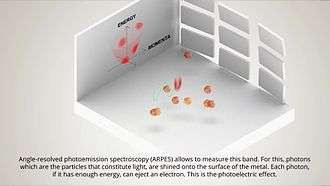Angle-resolved photoemission spectroscopy
| Condensed matter experiments |
|---|
 |
| ARPES |
| ACAR |
| Neutron scattering |
| X-ray spectroscopy |
| Quantum oscillations |
| Scanning tunneling microscopy |


Angle-resolved photoemission spectroscopy (ARPES), is a direct experimental technique to observe the distribution of the electrons (more precisely, the density of single-particle electronic excitations) in the reciprocal space of solids. The technique is a refinement of ordinary photoemission spectroscopy, studying photoemission of electrons from a sample achieved usually by illumination with soft X-rays. ARPES is one of the most direct methods of studying the electronic structure of the surface of solids.
ARPES gives information on the direction, speed and scattering process of valence electrons in the sample being studied (usually a solid). This means that information can be gained on both the energy and momentum of an electron, resulting in detailed information on band dispersion and Fermi surface.
The technique is also known as ARUPS (angle-resolved ultraviolet photoemission spectroscopy) when using ultraviolet light (as opposed to X-rays) to generate photoemission.
Band mapping
Band mapping, in condensed matter physics refers to the process which allows for detection (and measurement) of photoelectrons emitted from an observed surface at different emission angles. This process is employed ARPES. ARPES is used to investigate the electronic structure of solids, solid surfaces and interfaces.
By employing the band mapping process, several fundamental physical properties of a solid can be determined. The properties which can be determined using this process include (but are not limited to) the following:
- Kinetic energy of the electron(s);
- Elasticity;
- Electrical/Magnetic properties; and
- Optical properties.
The electronic states in the solid are described by energy bands, which have associated energy band dispersions E(k) — energy eigenvalues for delocalized electrons in a crystalline medium according to Bloch's theorem.
Band mapping has an advantage over optical spectroscopy. In the latter, only the energy-band separations at various optical critical points in k-space — entropy between the initial and final states — are determined. ARPES, on the other hand, provides information about the absolute location of energy bands at different values of k relative to the Fermi level (EF).
Theory
From conservation of energy, we have
where
- is the incoming photon energy — measured
- is the binding energy of the electron
- is the kinetic energy of the outgoing electron — measured
- is the electron work function (energy required to remove electron from sample to vacuum)
Photon momentum is often neglected because of its relatively small contribution compared with electron momentum.
In the typical case, where the surface of the sample is smooth, translational symmetry requires that the component of electron momentum in the plane of the sample be conserved:
where
- is the momentum of the outgoing electron — measured by angle
- is the initial momentum of the electron
However, the normal component of electron momentum might not be conserved. The typical way of dealing with this is to assume that the final in-crystal states are free-electron-like, in which case one has
in which denotes the band depth from vacuum, including electron work function ; can be determined by examining only the electrons emitted perpendicular to the surface, measuring their kinetic energy as a function of incident photon energy.
The equations for energy and momentum can be solved to determine the dispersion relation between the binding energy, , and the wave vector, , of the electron.
See also
- Electronic band structure
- Felix Bloch
- Laser-based angle-resolved photoemission spectroscopy
- Resonance Raman spectroscopy
- Two-photon photoelectron spectroscopy
References
- Park, Jongik. "Photoemission study of the rare earth intermetallic compounds: RNi2Ge2 (R = Eu, Gd)." 2004, Iowa State University, Ames, Iowa
External links
- Andrea Damascelli, "Probing the Electronic Structure of Complex Systems by ARPES", Physica Scripta T109, 61-74 (2004)
- Angle-resolved photoemission spectroscopy of the cuprate superconductors (Review Article) (2002)
- ARPES experiment in fermiology of quasi-2D metals (Review Article) (2014)